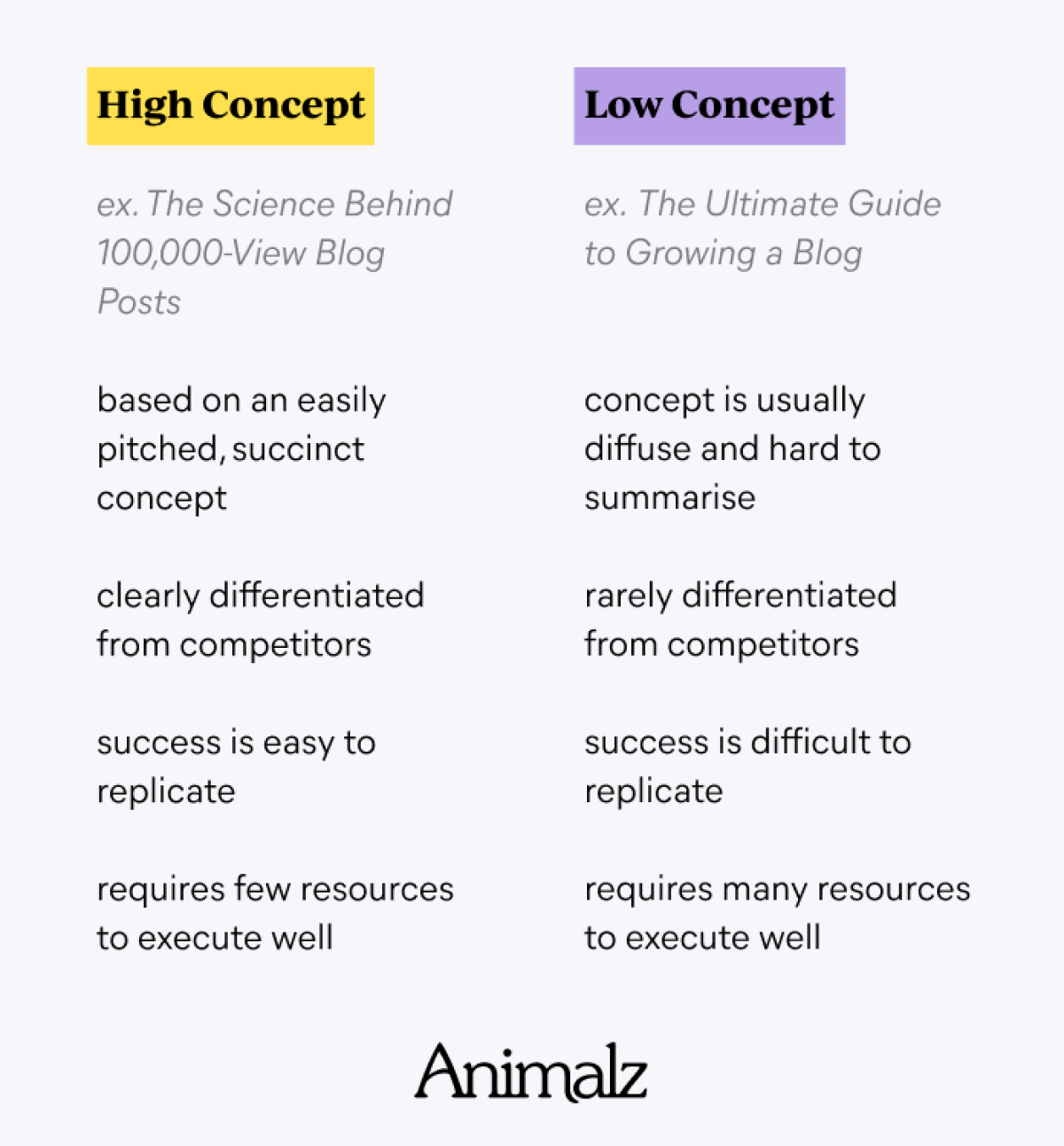Snakes on a Plane front-loads everything that’s interesting about the film into four short words. It’s a pithy summary of the entire plot. Walking into the cinema, the audience has clearly defined expectations: they want to watch a ton of snakes causing havoc on an international flight. It’s easy for the film to deliver on those expectations.Contrast with The Revenant. The title is cryptic, and the tagline is equally vague: Blood lost. Life found. The main themes of the film—revenge, the frontier fur trade, nature’s inhospitality—are completely absent. It’s impossible to walk into the cinema with precise expectations. The biggest draw is the film’s stellar cast and the hope that they’ll deliver a worthwhile experience.
In filmmaking, movies can be “high-concept” or “low-concept:”
High-concept movies are based on an easily pitched, succinct plot—like Snakes on a Plane
Low-concept movies rely less on plot and more on world-building and character development—like The Revenant
Hollywood thrives on high-concept movies because they’re easier to explain, easier to sell to the public, and easier to execute. Without a clear plot, low-concept movies must rely on the strength of their cast, or cinematography, or soundtrack to attract interest.
The same principle applies to content marketing. Some content is high-concept: the reader can immediately anticipate what the article is about and what the value is. Some content is low-concept: the value of the article isn’t immediately apparent, and it relies on great execution to make it satisfying.

With an Oscar-winning cast and crew behind it, The Revenant can pull off low-concept, but most films can’t. The same is true in content marketing. To stand the greatest chance of success, most content should be high-concept.
Why High-Concept Content Performs Better
The way most companies approach content marketing lends itself to low-concept content.Articles are often written to rank for a target keyword, like “facebook ads.” The easiest way to write that article is to create a generic, low-concept title—like “The Ultimate Guide to Facebook Ads”—and through the process of writing, try to add new and interesting information that other articles don’t include.
But to the reader, that new and interesting information isn’t apparent from the outset—it’s buried deep within the article.The harder-but-better approach is to front-load your thinking and surface new and interesting information from the get-go. For “facebook ads,” that might mean an article like AdEspresso’s “We Analyzed 752,626 Facebook Ads, and Here’s What We Learned.” Here, the value and direction are apparent: we’re getting data-backed advice from a huge sample size of original research.AdEspresso’s article received over 100k views, and for most businesses, high-concept content generally performs better:
It Stands Out
Many industries are saturated with copycat content, like “ultimate guides” and listicles—prime examples of low-concept content. The value of the articles isn’t obvious from the outset. Readers must wade through hundreds of words to find the value, if it exists at all.Take these real-world examples of low-concept content from the search results for “saas pricing:” The Ultimate Guide to SaaS Pricing Models; The Top 10 SaaS Pricing Strategies; 12 Different SaaSy Pricing Strategies; and SaaS Pricing Models & Strategies Demystified.One of the few high-concept examples from the “saas pricing” search results is an article from ProfitWell: How to 10x Your SaaS Prices with Enterprise SaaS Pricing. It tackles the same topic as its competitors, but instead of burying the lede with a generic format and title, it homes in on a specific and interesting nuance: how enterprise companies manage to successfully increase their price.
It Templatizes Success
If a high-concept film performs well, it’s easy to create similar movies based on the same winning formula. Sharknado proved this point, spawning a series of spin-offs and sequels that cashed-in on the original film’s scary animal + disaster scenario concept:
Sharknado 2: The Second One
Sharknado 3: Oh Hell No!
Sharknado: The 4th Awakens
Sharknado 5: Global Swarming
The Last Sharknado: It’s About Time
Sharktopus
Zombeavers
Lavalantula
If a viewer tunes into Sharknado, it’s a safe bet that they’ll enjoy films with a similar concept—each film in the franchise garnered between 1 – 4MM viewers. The same principle can be applied to content. If one high-concept article performs well, new articles can be created in the same vein, like SpyFu’s Airbnb vs. VRBO teardown, and its spiritual successors, HubSpot vs. Salesforce and Twitter vs. Medium.
It Requires Fewer Resources
The Revenant succeeded on the strength of its cast and crew, with the film’s actors, directors and crew netting 90 award wins and 186 nominations between them. Few films have the same toolkit to rely on. The same applies to content.While the First Round Review can pull off a low-concept article like “The Best Interview Questions We’ve Ever Published” because of its journalistic prowess, its experienced editorial team, and the strength of its reputation, other companies can’t. High-concept content levels the playing field. It allows smaller, scrappier teams to beat out bigger rivals through the power of good, clearly defined ideas.
How to Make Content More High-Concept
Low-concept article ideas can often be made more high-concept by making them more specific. Starting from a generic starting point—like a keyword—we can home in on one facet of the topic that we find most interesting, most contrarian, or most supported by our own experience.Anchor articles in the authority of recognizable people and brands via quotes, interviews with subject matter experts, even company-specific teardowns:
Before: 5 Ecommerce Growth Lessons
After: How Jeff Bezos Turned Narrative into Amazon’s Competitive Advantage
Explore the science that underpins the topic. Psychology is a great lens but so too are disciplines like economics or mathematics:
Before: How to Create Better Ads
After: The Psychology Behind Why People Dislike Ads (And How to Make Better Ones)
Use strong opinions and personal perspectives to elevate generic articles. Here, Amplitude goes a level deeper and more specific than a generic “how-to” and calls out common mistakes made within those calculations:
Before: Monthly Growth Rates Explained
After: 3 Mistakes You’re Making with Month-Over-Month Growth Rates
Tap your original data to bring a totally unique, concrete angle to an otherwise saturated topic. We did this on our own blog. From the get-go, the reader knows to expect concrete advice that’s based on a ton of real-world data:
Before: How to Improve Blog Performance
Each of the “before” articles buries the lede. It’s hard to know what to expect from the text and harder still to distinguish the piece from similar articles. The “after” articles still tackle the same core topic, but they do so in a more compelling, more specific, and more differentiated way.
High-Concept Is Low Risk, High Reward
As The Revenant proves, low-concept content can still be hyper-successful—but it necessitates greater resources to pull off and imposes a higher chance of failure. For most companies getting started with content marketing or working with constrained resources, high-concept content provides the best chance of success. Make each article as specific and concrete as possible, and front-load the value your content delivers.
